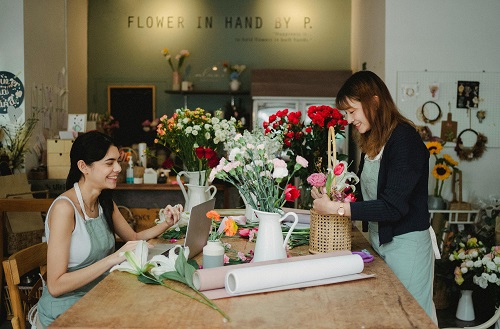Walk any busy high street at lunchtime and you can spot the shops that work. Clean sightlines pull you in, clear prices reduce hesitation, and staff can move without bumping into displays.
These are not happy accidents. Professional fitouts align layout, signage, lighting, and compliance to help people notice, enter, and buy. Teams like Revolution Retail streamline that process for multi-site retailers in Brisbane, Sydney, Melbourne, Perth, and Newcastle, which helps brands keep consistency while they scale.
 Photo by Amina Filkins
Photo by Amina Filkins
Make the storefront earn attention in three seconds
The first job of a shopfront is to signal offer and credibility fast. Start with glass clarity and reflections. Use lighting that puts products, not customers, in the spotlight. Position a single hero message at eye level, then back it with a visible price point to reduce decision friction. Keep sandwich boards simple and legible from five metres.
Inside the threshold, build a decompression zone. Give customers one or two steps to adjust to temperature, light, and sound. Place the first focal display just beyond that zone so traffic flows naturally, rather than stopping at the door and blocking others.
Layouts that convert browsers into buyers
Once people step in, layout turns attention into movement and movement into baskets. Map a clockwise or anticlockwise loop that touches core categories and ends near a tidy queue. Use a “power wall” to introduce new or high-margin items. Keep aisles wide enough for prams and mobility devices, then locate small add-ons near the point of sale to encourage easy top-ups.
Plan for product placement with a clear planogram so staff can reset quickly after busy periods. A planogram is simply a diagram that shows where products live on shelves and fixtures, and it improves stock control and visual consistency (Wikipedia: Planogram). When stock turns fast, a published plan makes training easier and keeps the store looking like the brand you advertise online.
Fitouts that support local search and discovery
Physical design and local marketing work better when they are planned together. Add permanent NAP details (name, address, phone) to an interior wall near the counter so staff can photograph it for listing updates. Schedule quarterly photos of the entrance, counter, and seating to keep your Google Business Profile current. Use consistent category imagery so your store photos match the look and promises on your local pages.
Think about review flow. A tidy queue area with visible service standards and clear pricing reduces frustration, which often improves the tone of customer feedback. If you run events or tastings, build a simple, movable fixture that looks good in photos. Those photos help your local content surface in discovery searches like “best gift store near me” and “late-night chemist”.
Materials, compliance, and wayfinding that protect margins
Attractive design does not help if flooring fails or signage confuses. Choose durable finishes for the heaviest traffic paths and test how carts or trolleys roll on them. Install lighting that shows true product colour, then document replacement specs so stores avoid mismatched bulbs later. Confirm counter heights, ramp gradients, and manoeuvring clearances with your certifier before you order casework.
Wayfinding matters as much as style. Directional signs, category markers, and a readable store map reduce search time and staff interruptions. Good wayfinding, the practice of helping people orient and navigate a space, boosts throughput and reduces stress for customers and staff alike (Wikipedia: Wayfinding). Use the same typefaces and icon sets online and in store so your brand feels consistent across touchpoints.
Timeframes, budgets, and rollouts customers never notice
Great fitouts feel effortless to shoppers because the hard work happens before a single fixture lands on site. Build a programme that locks down lead times for joinery, refrigeration, lighting, and signage. Sequence noisy works after hours where possible. Confirm landlord approvals early to avoid late changes.
Multi-site retailers benefit from standardised joinery and fast install kits. That reduces time on site and makes maintenance predictable. Experienced partners coordinate drawings, procurement, trades, and safety paperwork so stores open on time and on budget, and staff return to a space that works from day one.
Office fitouts that mirror retail standards
If your head office or back-of-house looks and flows like your shops, training becomes easier. Use the same materials and signage conventions in meeting rooms and staff areas. Add storage and charging to reduce clutter. Keep collaboration areas acoustically separate from quiet work so teams can switch between tasks without losing focus.
When the office and shop share a design language, brand decisions move faster. Sample walls, small mock bays, and lighting demos let teams test ideas before a full rollout, which saves money and reduces risk.
Practical store readiness checklist
Use a short, repeatable checklist before opening or relaunching a site. It keeps teams honest and makes results easier to compare across locations.
- Sightlines from the door to the first focal display are clear
- Decompression zone is free of obstacles and pricing is visible
- Power wall features a new or high-margin range with supporting signage
- Queue is tidy, with small add-ons in reach and no cable clutter
- Photos of entrance, counter, and key categories are captured for listings
 Photo by Antonio Sokic
Photo by Antonio Sokic
Bringing fitout and marketing together
Top4’s audience knows that local visibility and strong reviews do not happen by chance. They come from spaces that are easy to enter, simple to navigate, and consistent with what people see online. Professional partners can close the gap between concept and completion so retail and office environments support both brand promises and day-to-day operations.
A well planned fitout earns attention in seconds, moves people through a clear loop, and makes it easy to buy. Pair that with disciplined local content and a reliable photo rhythm, and your store becomes easier to find, easier to love, and easier to run.


































